The Visionary CEO’s Guide to Sustainability

At a Glance
- To achieve ambitious decarbonization targets, companies must treat emissions with the same operational importance as improving efficiency and reducing costs.
- Of companies that have set a target to reduce upstream Scope 3 emissions, 60% do not have a dedicated strategy to deliver, our research shows, but those that do can build this into a competitive advantage.
- We have identified four actions leading companies take that contribute to decarbonization success, practices any company can benefit from emulating.
This article is part of Bain’s 2023 CEO Sustainability Guide
Decarbonization is urgent. Countries representing 90% of the world’s GDP have committed to cutting greenhouse gas emissions to as close to zero as possible, and investors, customers, regulators, and employees are all focused on carbon. Companies across industries are setting ambitious goals for reducing various types of carbon emissions (see Figure 1). As of October 2023, more than 6,000 companies representing close to 50 different sectors had set or committed to setting Science Based Targets for emissions reduction. That’s up from fewer than 500 companies in 2018.
Each company and industry faces its own unique decarbonization challenges and opportunities, but it’s fair to say that organizations across the board are struggling to meet their increasingly ambitious targets. A Bain & Company analysis of CDP data finds that more than 20% of companies are not on track to reach their reduction targets for the Scope 1 emissions generated by assets they own and operate or the Scope 2 emissions generated by purchased electricity and fuel. More than a third may not meet their planned reduction of upstream Scope 3 supplier emissions (see Figure 2).
A guide to emission types
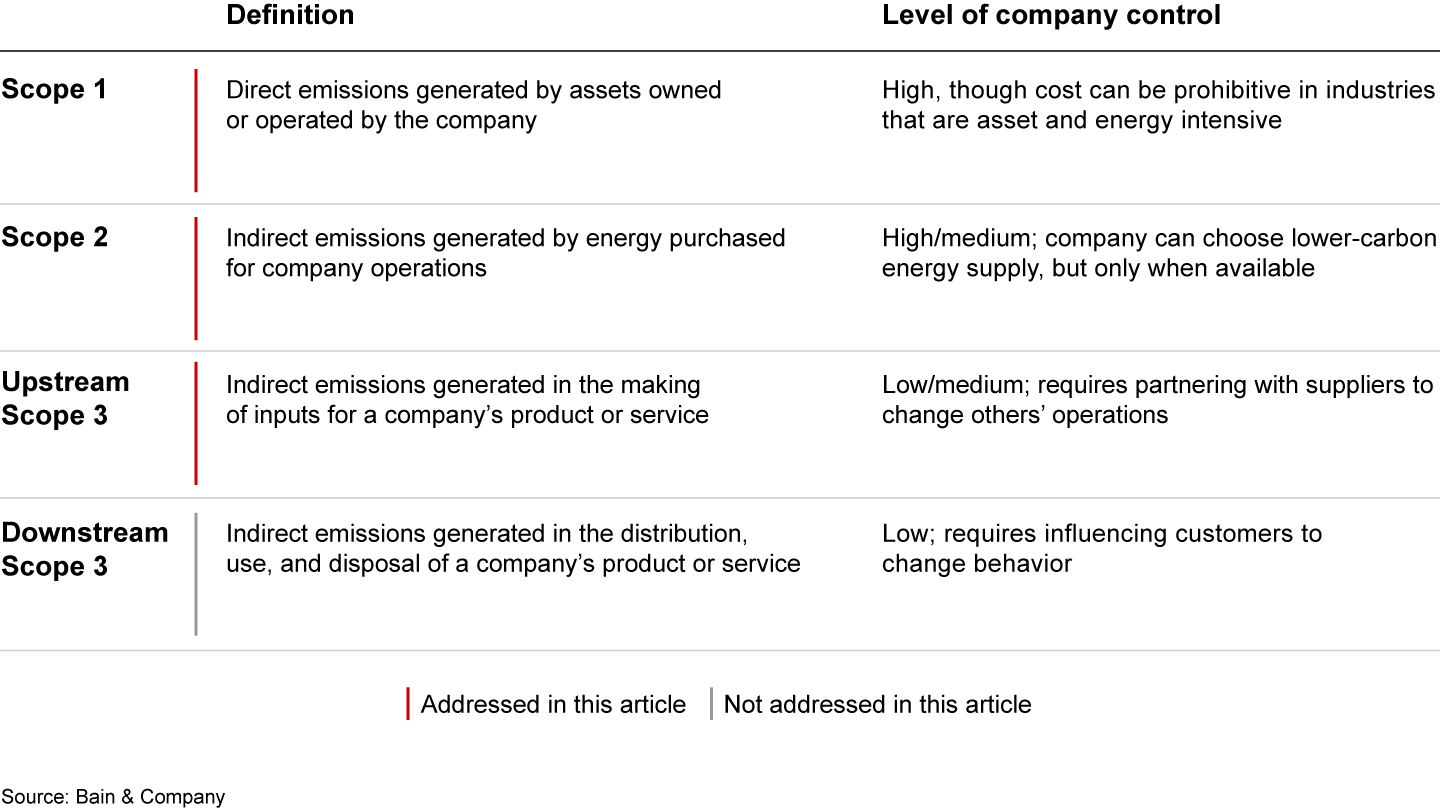
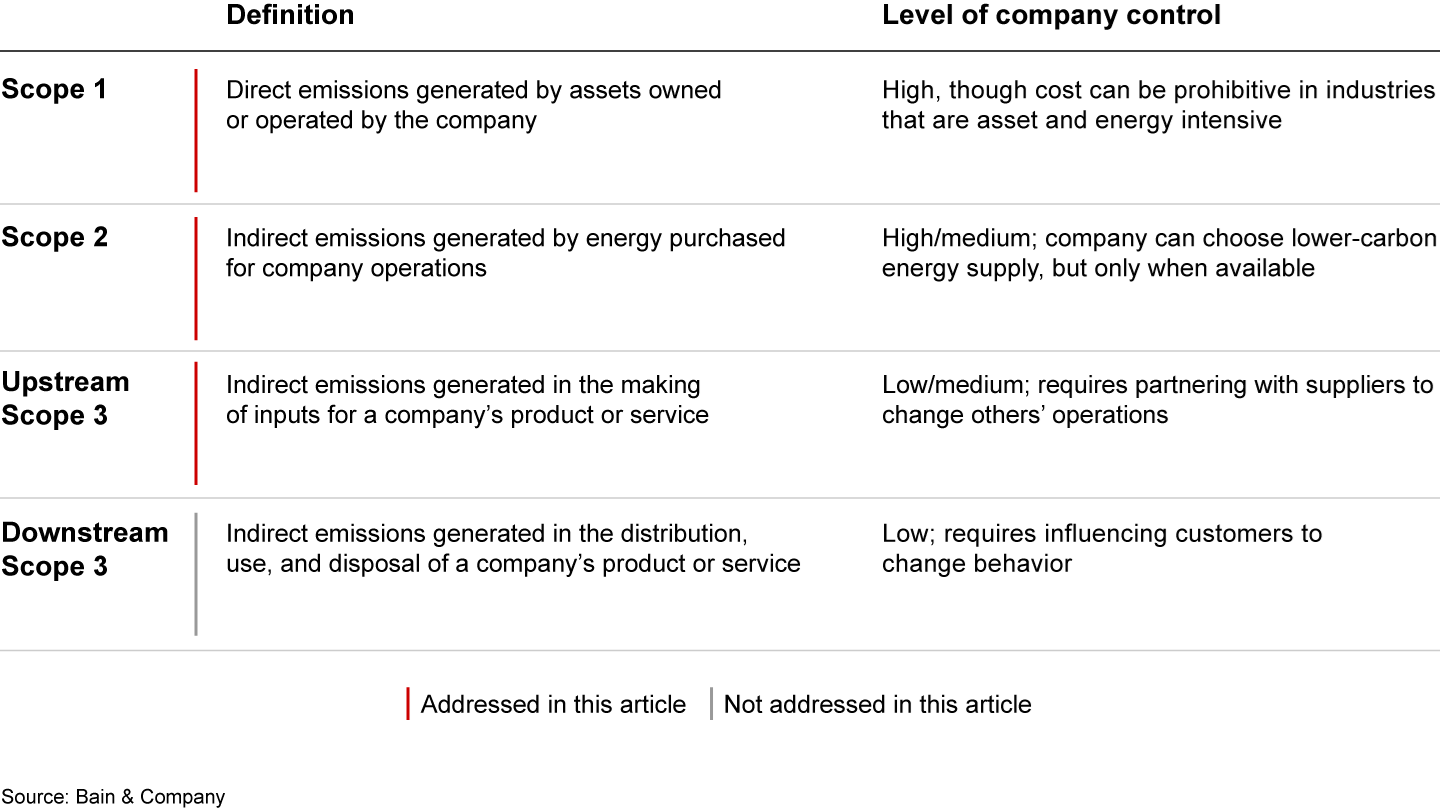
More than one in five companies are not on track to meet their Scope 1 and 2 decarbonization targets, and more than one-third are lagging their upstream Scope 3 goals
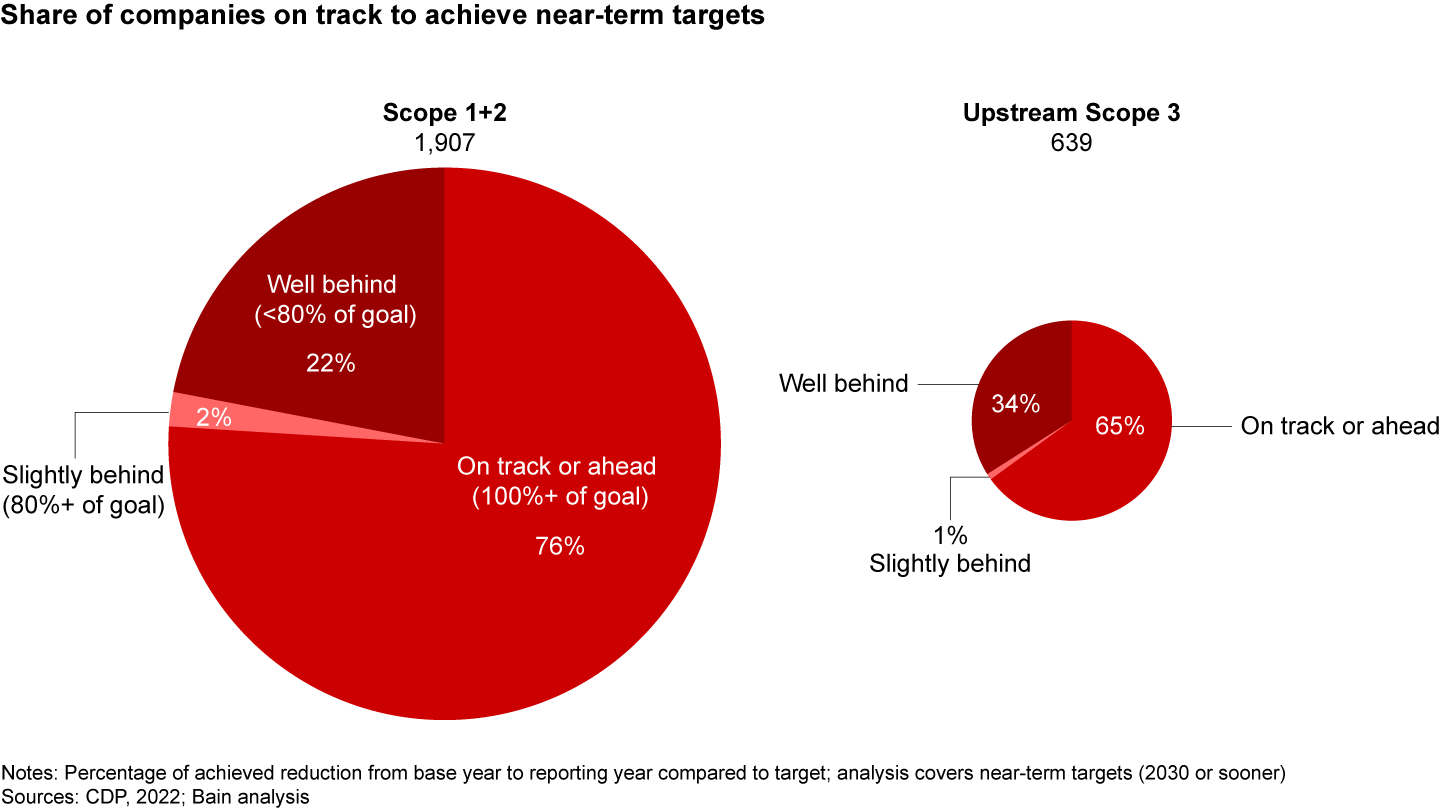
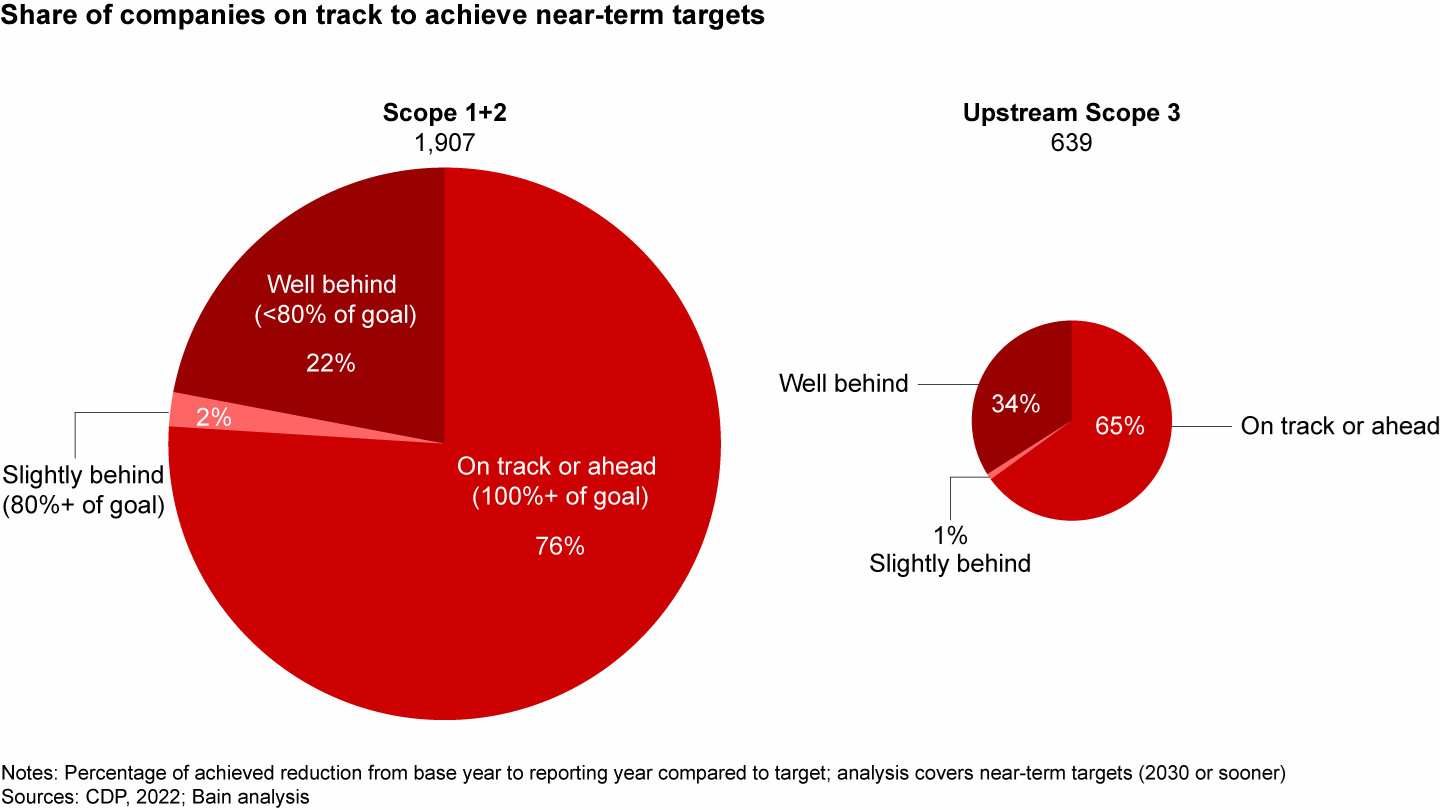
Decarbonization is critical to operational excellence
To improve those numbers, companies must embed reduction of their carbon footprint into their operating model and treat it with the same importance as improving efficiency and reducing costs. Production efficiency, cost, and carbon emissions can be seen as three corners of a “triangle of optimization,” each requiring equal and parallel attention. When well harmonized, they can benefit one another. This approach is particularly true for Scope 1 and 2 emissions, which often can be reduced while also lowering costs.
A paper manufacturer was able to do just that: By defining and prioritizing 70-odd decarbonization initiatives across 10 different sites, it is currently on track to reduce emissions by more than 20% by 2025 while achieving €10 million to €15 million in energy savings. In many industries, executives link decarbonization efforts with energy transition and energy efficiency as a way to reduce their exposure to volatile energy costs.
Most companies start their decarbonization efforts with Scope 1 and 2 emissions because they are closer to their own control. That doesn’t mean they are easy to address, however. These efforts require new thinking about energy consumption, sourcing, and production, along with the ability to orchestrate extraordinarily complex change.
When a global semiconductor manufacturer launched a comprehensive plan to reduce greenhouse gas emissions and shift its energy sources to address Scope 1 and 2 emissions, management quickly identified more than 600 initiatives. Managing such an expansive pipeline is a complex challenge. To prioritize, management pinpointed those with the highest CO2e impact that were easiest to implement and focused on understanding their cost—a model they have now standardized across the company. Lots of work was done on the ground to determine the right energy sources for each plant and to ensure goals were achievable and optimized for both energy efficiency and the sourcing of renewable energy. Early results have been strong: a reduction of Scope 1 and 2 emissions that’s roughly 10% higher than plan and a notably higher-than-expected use of renewable energy.
Like this semiconductor maker, many companies are able to achieve their Scope 1 and 2 ambitions in the first few years by making their operations more efficient and reducing their energy use. It’s when they get beyond those first successes and face external expectations of a steady annual rate of emissions reduction that they start to really struggle. Decarbonization requires more than mastering the handful of technical operational levers that will make an immediate dent in Scope 1 and 2 emissions.
Upstream Scope 3 emissions: for many, the biggest opportunity and the biggest challenge
Upstream Scope 3 accounts for the largest share of emissions in many sectors, responsible for more than 50% of all emissions in apparel, food and beverage, chemicals, and retail, for example, according to CDP data. This may be why, while the number of companies setting targets across all scopes strongly increased in recent years, the most significant growth has come in Scope 3 emissions. More than 4 in 10 companies now target Scope 3 improvement.
Meeting those targets often requires new skills and behaviors, some of which may be unfamiliar to engineers focused on optimizing performance and procurement experts charged with negotiating the best terms, sometimes adversarially. These include partnering with suppliers and other participants in the value chain, identifying and selecting greener suppliers, replacing virgin materials, and designing products with a lower carbon footprint.
Adding to the challenge is the fact that, in many categories, sustainable supply is limited, leaving companies two options: invest to secure access to that supply and possibly buy a few years’ head start on competitors, or accept that achieving their emissions reduction goals may take longer than hoped.
As with Scope 1 and 2, a well-developed upstream Scope 3 plan can help mitigate cost when integrated into a company’s broader supply chain strategy, including a combination of product development optimized for cost and product development optimized for sustainability.
According to Bain research, approximately 60% of companies that set an upstream Scope 3 target do not have a dedicated strategy or plan to deliver on that goal. Those that do can build this into a competitive advantage.
Four lessons from successful supply chain decarbonization efforts
As they plan their strategy to get to net zero, executives should consider these four lessons from leading companies.
When calculating baseline emissions, be pragmatic; don’t wait for perfection. Establishing a baseline for your operational emissions can be challenging, especially for the upstream Scope 3 emissions that companies do not directly control. While an accurate baseline enables more precise goal setting, don’t prioritize perfection over action. It’s most important that analytical efforts to understand existing carbon emissions serve the company’s action plan by highlighting interventions with the highest potential to help meet goals. By systemizing carbon baselining and accounting—with software tools, for example—and how data is exchanged with suppliers, companies can build a level of insight into their emissions that will only get more precise over time.
Collaborate internally and externally. Achieving decarbonization goals can’t be the responsibility of one internal function. Procurement shouldn’t be the only department thinking about suppliers’ upstream Scope 3 emissions, nor should a plant manager be expected to manage Scope 1 and 2 emissions reduction all alone. Companies will only hit their decarbonization goals when the entire organization, from the C-suite to the front line, in every business unit, is committed to and educated on the mission. Building that commitment often requires aligning incentives across functions and roles around common decarbonization goals.
Think beyond the boundaries of your organization to the ecosystem of partners you’ll need to realize your decarbonization ambitions. As partners, companies and their suppliers can work together to understand where they each wish to be positioned on the value chain. Getting there may require new approaches, like investing to help suppliers lower their emissions or building a consortium of peers to standardize new, lower-carbon requirements. That’s the approach taken by the 100-plus consumer products companies that make up The Sustainability Consortium, which is working on ways to make supply chains more transparent, identifying areas of environmental impact, mapping supply chains and their risks, and facilitating collective sustainability innovation.
Use all levers at your disposal and put in place the tools necessary for them to work. Once targets are set, identify all levers that could help you meet them. For example, you may need to switch suppliers or redesign a product. Many firms focus on the low-hanging fruit that will quickly reduce carbon emissions, but companies should think about their overall decarbonization journey, including initiatives that will take more time, innovation, or development.
Enablers are also important. These are the tools—like internal carbon pricing; new ways of interacting with, evaluating, and rewarding suppliers; and capability building—that will make it possible to pull the levers that lower emissions. Though it may sound obvious, it’s important to prioritize initiatives based on their potential to reduce carbon, reduce costs, and increase resilience. Many companies miss this step. And since many decarbonization initiatives cannot be implemented autonomously, suppliers and customers should be engaged in evaluating their feasibility, priority, and potential to either lower costs or increase revenue (see Figure 3).
Reducing upstream Scope 3 emissions requires action on multiple fronts
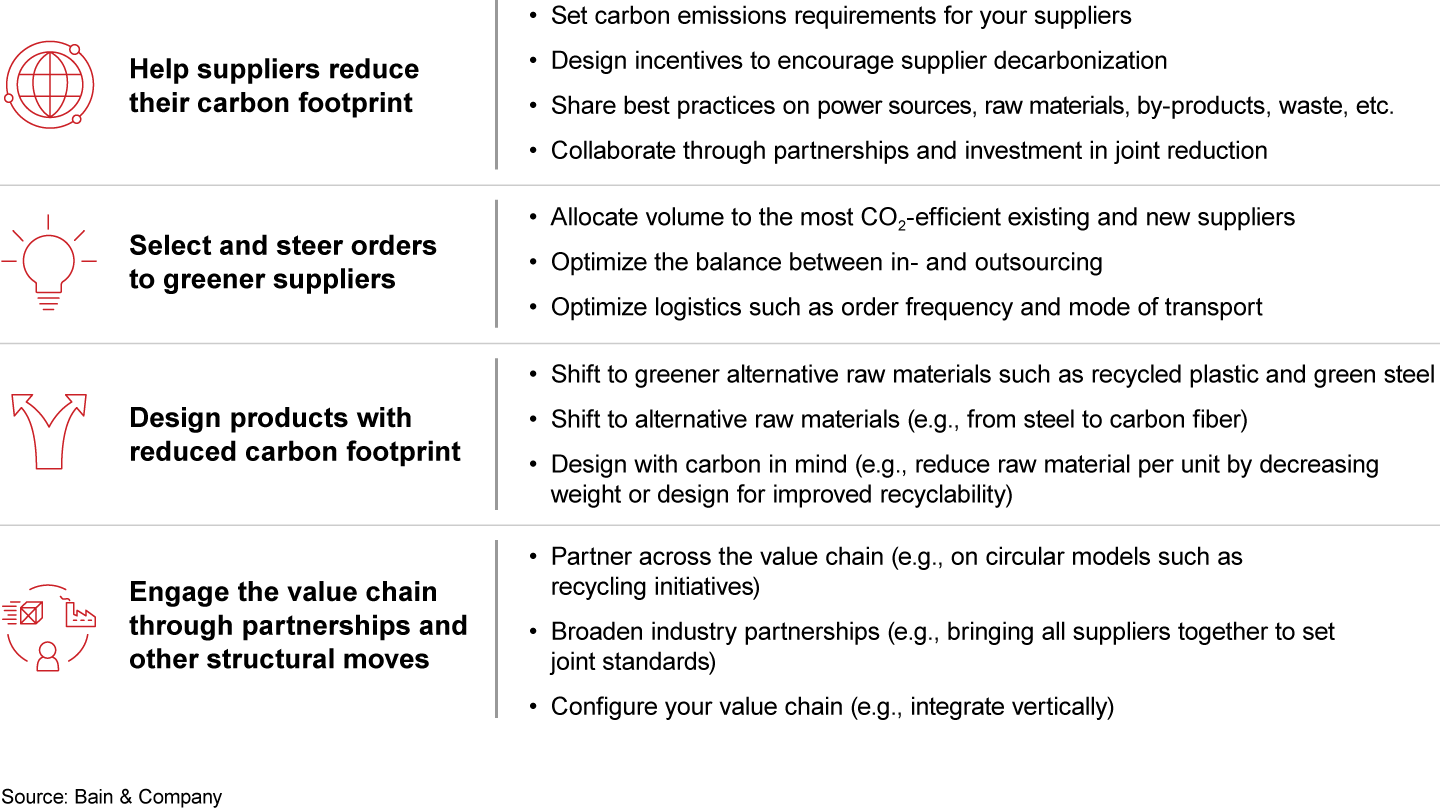
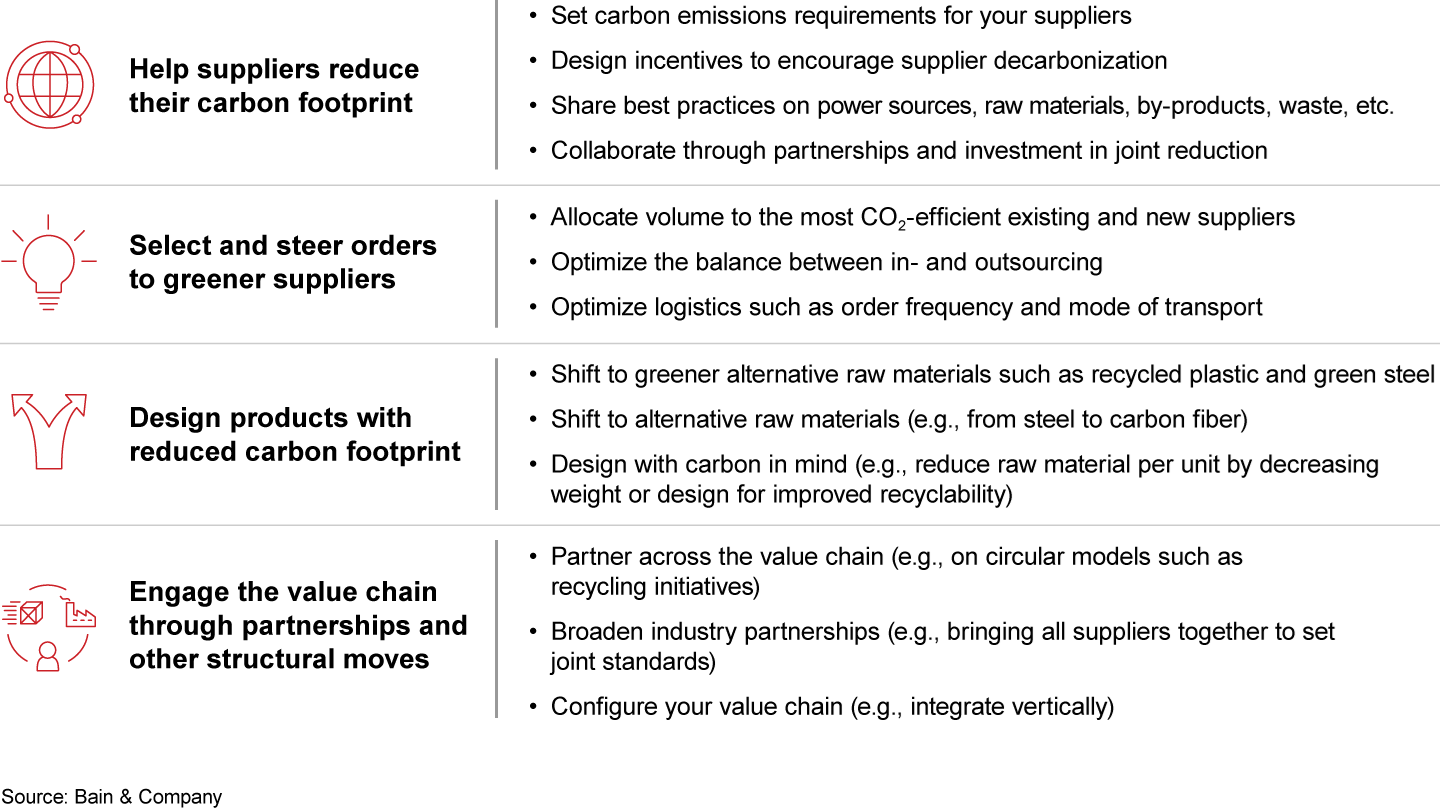
Near-term steps such as managing suppliers can offer valuable carbon reductions, but it’s often longer-term efforts that present the greatest opportunities. In the automotive industry, for example, designing low-carbon alternatives for metals, alternative raw materials, and low-carbon products can reduce upstream Scope 3 carbon emissions by approximately 40% to 60% or more, but such efforts may take years. To speed that up, manufacturers are collaborating with, investing alongside, and guaranteeing to buy supply from steelmakers producing CO2-reduced green steel.
Actively look to create value for your company and customers through decarbonization. While there may be a legacy perception that reducing carbon emissions will increase costs and decrease economic competitiveness, many initiatives can lower costs and help increase revenue. For example, reducing Scope 2 emissions by optimizing building operations like HVAC and lighting saves money, savings that can be passed on to customers or used to fund other decarbonization initiatives. Similarly, companies may be able to boost revenue by charging a green premium or build new businesses with different models that create value for the firm. Thinking about your customers’ priorities can help guide decarbonization efforts and increase the likelihood of achieving carbon reduction goals and reaping rewards from a low-carbon supply chain.
Five questions for executives to ask today
To understand how close your company is to making decarbonization a core operational capability and a source of competitive advantage, it’s valuable to ask five questions:
- What is my company’s emissions trajectory, and how does that compare to the targets we’ve set?
- Has my team spent time on the shop floor (or its equivalent) to understand where renewable energy and energy efficiency could be used?
- Do our procurement and engineering teams consider carbon equally important to cost and efficiency in their talks with suppliers and when designing products?
- Have we added decarbonization to our management dashboard, so we see it alongside our financial performance and operational efforts?
- Have we invested in building the capabilities we need in our team, and do we have training in place for our people to develop the skills that will help us reach our decarbonization goals?